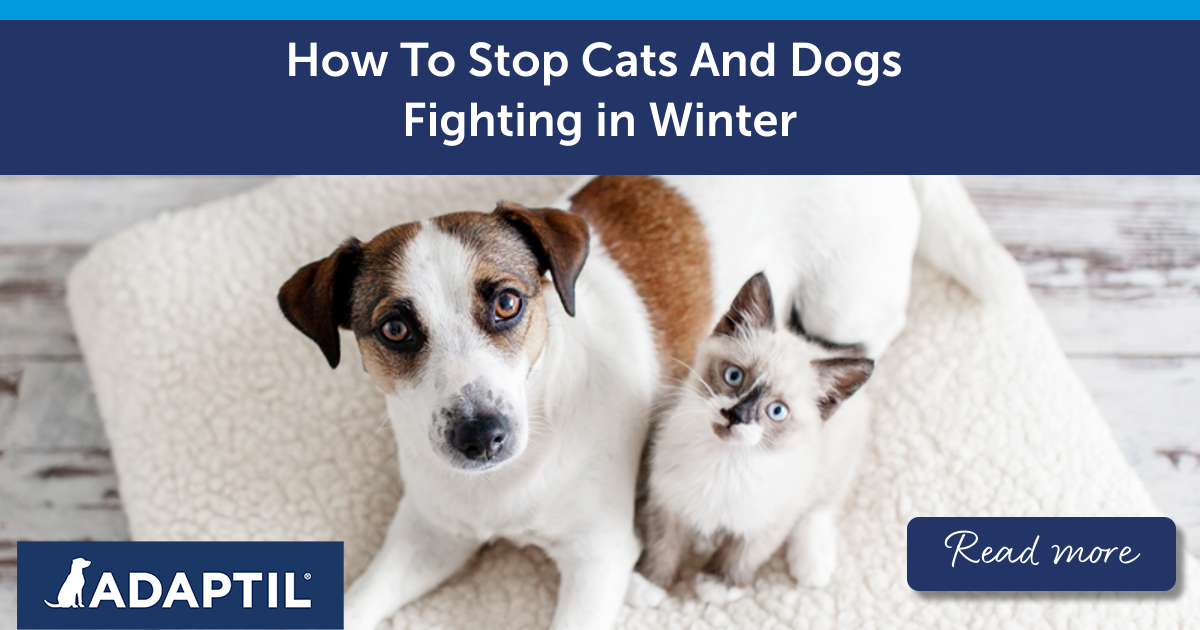
How To Stop Cats And Dogs Fighting In Winter
The chances are, you’ve probably heard the phrase ‘Fighting like cats and dogs.’ The quote is so old in fact that it goes right the way back to Shakespeare’s time! But just because this famous rivalry has been around for centuries, it doesn’t have to describe the relationship between our own pets. So, how to stop a cat and dog fighting?
While winter can make everyone a little irritable, particularly with our pets spending more time indoors due to the cold, it’s still possible for everyone to get along. Ensuring a positive relationship is a simple case of understanding our pets’ unique personalities, needs, and communication styles. Keep reading to learn why dogs may be aggressive towards cats, plus find our tips to stop them fighting!
Why Do Dogs and Cats Fight?
When we ask why cats and dogs fight so much, it’s essential to recognise that they possess inherently different communication styles and social structures. Some cats and dogs may become inseparable friends, but they will often merely tolerate one another. As well as their inherent differences, a lot depends on their individual personalities, early exposure to the other species, and the environment they live in.

There are differences in their natural behaviours too. Cats, being historically solitary hunters, often exhibit stalking or pouncing behaviours. On the other hand, many breeds of dog are hard-wired to chase smaller animals. They’re also active during different times of the day. For instance, cats are most active during twilight, while dogs are active during the day.
How To Help Cats And Dogs Get Along
Despite their differences, there are steps we can take to minimise aggressive behaviour and hopefully encourage a positive relationship between cats and dogs. Remember, the goal isn’t necessarily to make them best friends but to ensure they can peacefully coexist. If you’re concerned your dog is being aggressive towards your cat, or vice versa, follow this advice to create a harmonious household:
1. Separate Spaces for Each Pet
Sharing an indoor space can lead to frustrations if a pet feels their space is encroached upon. This is likely to worsen during the confinement of winter. To limit this, ensure both cats and dogs have their unique areas where they can retreat and relax without the other’s interference. Elevated spots are especially effective as they provide spaces for cats to retreat to when they wish to avoid a dog’s attention.
2. Equal Attention between Cats and Dogs
When you’re introducing a new pet to the family, it’s always tempting to pamper the newcomer. However, this can often lead to jealousy. Make sure you maintain the routine of your original pet, giving them their regular playtime, grooming, and attention. This balance will help prevent any feelings of neglect.

3. Provide Your Pets with Mental Stimulation & Exercise
Keeping our pets mentally and physically stimulated reduces the chances of cats and dogs fighting. Whether ensuring your dog is getting their regular winter walks or providing your cat with toys to pounce on, it’s crucial they both have outlets for their energies.
Here's 5 top tips to mentally stimulate your dog in Winter.
4. Use species specific pheromone support
Bear in mind that stress or anxiety could be a factor behind any aggressive behaviour between your cat and dog. Consider incorporating pheromone products into your home that can ease these tensions. For dogs, ADAPTIL contains the Dog Appeasing Pheromone - the Calm Collar offers continuous support and is a great way to keep a pooch relaxed and settled. A Calm spray is ideal for targeted action on your dogs bed or crate.
For cats, FELIWAY Optimum is contains a complex of feline pheromones. You don’t need to worry about prioritising one pet over the other! ADAPTIL and FELIWAY diffusers work absolutely fine alongside one another as the pheromones, a natural way animals communicate are species specific.
5. Introduce your pets to each other gradually
When introducing pets to one another, it’s best to approach this in stages. Begin with scent swapping, placing material that you’ve used to stroke one pet in the other’s environment. Once they’ve each had time to become relaxed with the other’s scent, move on to being able to explore the other’s environment.
Next, establish visual contact while both are calm and relaxed. And lastly, when you feel they’re ready, establish physical contact. Limit this to short sessions initially and supervise throughout. It’s good to keep your dog on a loose lead, just in case, and provide your cat with plenty of escape options should they feel like retreating.

6. Understand Body Language
Learn to recognise the difference between playful chasing and actual fighting. For instance, if a cat’s claws are retracted during a chase, it’s likely a game. A dog growling at a cat, on the other hand, would suggest they’re uncomfortable with the cat’s presence. If you spot this behaviour, separate the two and consider resuming their gradual introduction once they’re both feeling more relaxed again.
Canine And Feline Friendships
The relationship between cats and dogs isn’t always straightforward, but don’t give up! With patience, understanding, and the right tools (such as ADAPTIL Calm or FELIWAY Optimum), a harmonious home is achievable. With the right strategies, the winter season can be a time of warmth and relaxation for both your feline and canine companions. And remember, if you’re ever in doubt, seeking professional advice from a vet or an accredited behaviourist can offer tailored solutions for your situation.
Are you looking for further advice to help with your cats and dogs fighting? Get in touch! We’re always happy to help in any way we can. You can also stay informed with our latest tips and guides, as well as find information about all our ADAPTIL products, by signing up to our newsletter.









































